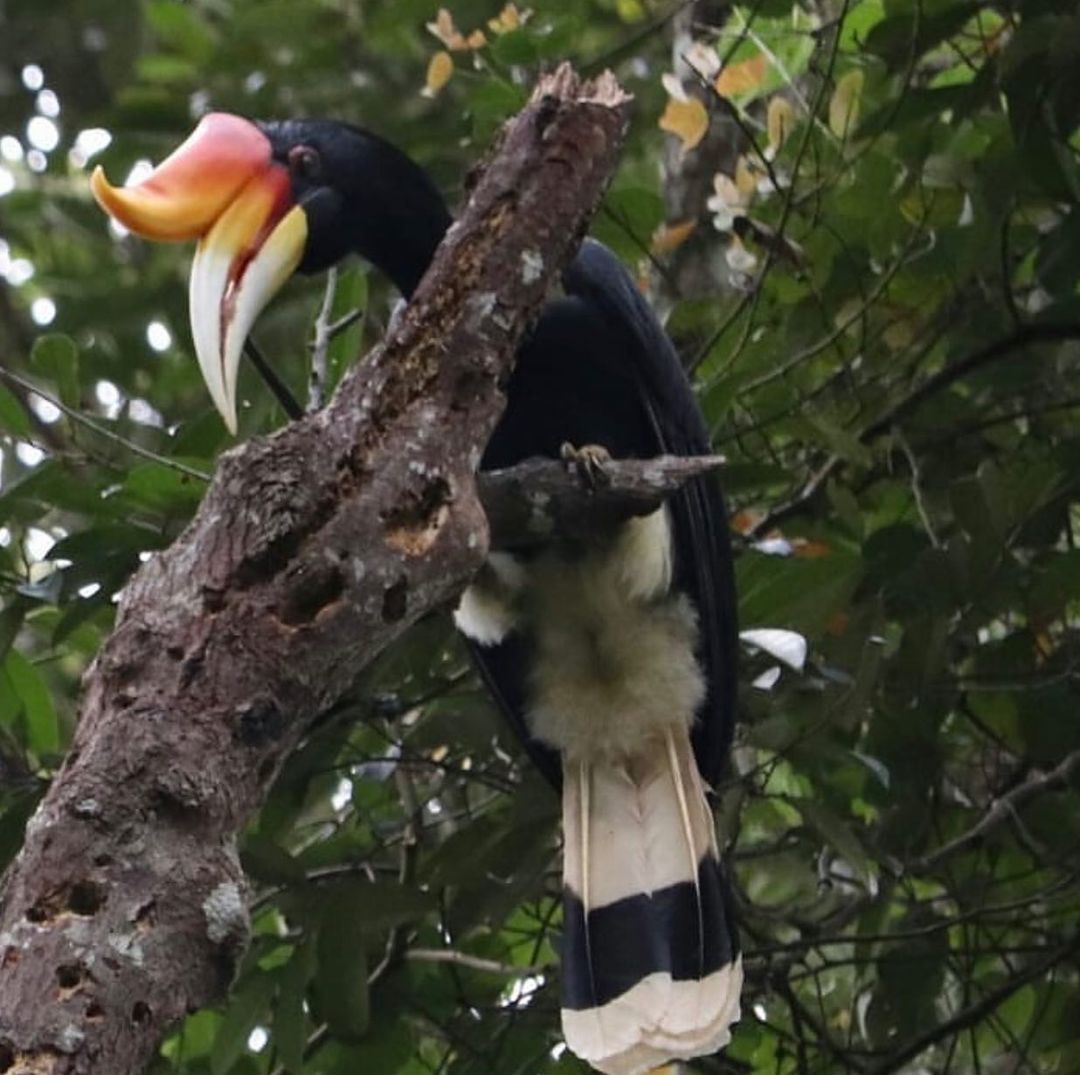
Rhinoceros hornbill
The rhinoceros hornbill is the state bird of the Malaysian state of Sarawak and the country’s national bird. Some Dayak people, especially the Ibanic groups, believe it to be the chief of worldly birds or the supreme worldly bird, and its statue is used to welcome the god of the augural birds, Sengalang Burong, to the feasts and celebrations of humankind. Contrary to some misunderstandings, the rhinoceros hornbill does not represent their war god, who is represented in this world by the brahminy kite. It is featured on the reverse of the 5 Malaysian ringgit bill.
The rhinoceros hornbill (Buceros rhinoceros ) is a large species of forest hornbill (Bucerotidae). In captivity, it can live for up to 35 years. It is found in lowland and montane, tropical and subtropical climates and in mountain rain forests up to 1,400 metres in Borneo, Sumatra, Java, the Malay Peninsula, Singapore, and southern Thailand.
| KINGDOM | Animalia |
| PHYLUM | Chordata |
| CLASS | Aves |
| ORDER | Bucerotiformes |
| FAMILY | Bucerotidae |
| GENUS | Buceros |
| SPECIES | Buceros rhinoceros |
| POPULATION SIZE | UNKNOWN |
| LIFE SPAN | 35 YRS |
| WEIGHT | 2-3 G |
| LENGTH | LENGTH 80-90 CM |
| WINGSPAN | 152 CM |
Appearance
Rhinoceros hornbills are large colorful birds found in tropical forests of Southeast Asia. They are predominately black in color, with white legs and vent and a white tail with a black band. Their huge bill and casque are orange and red. The eyes of the male are red with black rims, and white with red rims in the female.
Distribution
Geography
| CONTINENTS | Asia |
| SUBCONTINENTS | Southeast Asia |
| COUNTRIES | Brunei, Indonesia, Malaysia, Thailand |
| BIOGEOGRAPHICAL REALMS | Indomalayan |
| WWF BIOMES | Tropical moist forests |
Rhinoceros hornbills are found in lowland and mountain rain forests in Borneo, Sumatra, Java, the Malay Peninsula, and southern Thailand.
Biome: Forest
Climate zones: Tropical
Habits and Lifestyle
Rhinoceros hornbills are non-migratory diurnal birds. They live and spend time in pairs, however, sometimes they may gather in small flock while feeding. Within these flocks, breeding pairs stay close to each other and the males usually feed the female in order to maintain their pair-bond. Rhinoceros hornbills are territorial birds with pairs constantly flying around their territories and during the breeding season defending them with loud trumpeting calls. Hornbills enjoy sunbathing and often perch with spread wings facing the sun.
| GROUP NAME | flock |
| LIFESTYLE | Arboreal, Gliding, Terrestrial, |
| SEASONAL BEHAVIOR | Not a migrant |
Diet and Nutrition
Rhinoceros hornbills are herbivores (frugivores) and carnivores. The primary diet of these birds consists of fruit, especially figs but they will also consume insects, small reptiles, rodents, and smaller birds.
DIET: Herbivore, Frugivore, Carnivore
Mating Habits
| MATING BEHAVIOR | Monogamy |
| REPRODUCTION SEASON | January-April |
| INCUBATION PERIOD | 40 days |
| INDEPENDENT AGE | 8.5 months |
| BABY NAME | chick |
| WEB.ANIMAL_CLUTCH_SIZE | 1-2 eggs |
Rhinoceros hornbills are monogamous and mate for life. They breed from January until April. The courtship and bonding of these birds are critical, as the female must trust the male to provide her with everything when she is incubating and raising chicks. Rhinoceros hornbills make their nests inside tree trunks, and the female stays inside with the eggs and then with the chicks, while the male brings them food. After the eggs are laid, the male collects mud and the pair pack that mud, along with food and feces, to wall up the entrance to the tree cavity. They leave a very small hole, just large enough for the male to feed the female, and later the chicks. The female usually lays 1-2 white eggs and incubates them within 40 days. During this period the female undergoes a complete molt. When the chicks are 1 month old, the female leaves the nest and seals the entrance again. The chicks leave the nest when they are 80 days old but the parents continue to feed them for another 6 months.
Population
Population threats
The main threats to Rhinoceros hornbills include the loss of their rainforest habitat, as well as hunting for their meat, skull, and feathers. Habitat destruction has led to the loss of the large trees the birds require for breeding, which in turn makes it easier for poachers to find Rhinoceros hornbills. These beautiful birds are also frequently shot at by poachers due to confusion with the highly sought-after Helmeted hornbill.
Population number
The IUCN Red List and other sources don’t provide the number of the Rhinoceros hornbill total population size. Currently, this species is classified as Vulnerable (VU) on the IUCN Red List and its numbers today are decreasing.
Ecological niche
Rhinoceros hornbills feed mainly on fruit and disperse seeds of many forest tree species.
| POPULATION TREND | Decreasing |
| POPULATION STATUS | Vulnerable (VU) |

